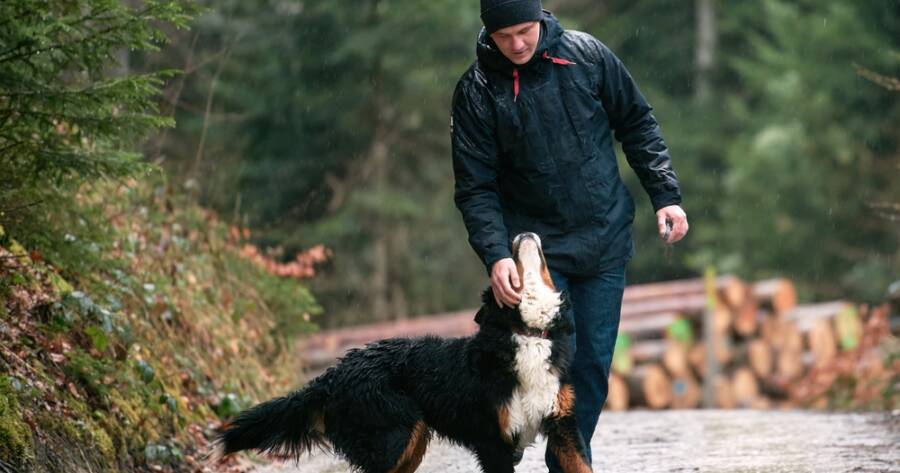Dogs may not speak our language, but they communicate volumes through their body language. From wagging tails to perked ears and playful bows, every movement expresses emotion and intent. Recognizing these signals helps strengthen the bond between dogs and their owners, creating a deeper understanding of their needs, feelings, and moods. Whether showing excitement, anxiety, or curiosity, a dog’s body language offers valuable insights into what they’re really thinking and feeling.
Signs Your Dog is Relaxed and Comfortable
A relaxed dog has an easygoing posture, loose muscles, and a slightly open mouth, often resembling a soft smile. Their ears rest naturally, not pinned back or overly alert. When lying down, they may stretch out completely, showing they feel safe in their environment. A slow, steady tail wag or even a gentle swaying motion of the tail further indicates contentment.
In social situations, a relaxed dog will calmly observe their surroundings without excessive tension. Their eyes appear soft, blinking naturally instead of wide or fixated. A dog that willingly exposes their belly or rests with their back toward you demonstrates trust and security. Understanding these relaxed signals helps reinforce a peaceful and positive bond between you and your pup.
Recognizing When Your Dog is Happy
A happy dog is full of energy and enthusiasm. Their tail wags freely, sometimes in full-body excitement. Their ears may perk up, and they might bounce or do a playful “zoomie” around the room. Happy dogs often initiate play by bowing—front legs stretched out while their back end stays high. This is an invitation to interact and have fun.
A happy dog may also engage in friendly behaviors like licking, nuzzling, or bringing you their favorite toy. Their eyes will appear bright, and their overall posture will be loose and wiggly. Some dogs even “smile,” showing their teeth in a non-threatening way. Recognizing these behaviors allows you to encourage playfulness and maintain a joyful, trusting relationship with your furry friend.
How to Tell if Your Dog is Anxious or Nervous
An anxious dog often displays subtle but important signs of discomfort. Yawning, lip licking, or excessive panting can indicate stress, especially if they are not tired or hot. A tucked tail, flattened ears, and a lowered head suggest nervousness or insecurity. They may also avoid eye contact or turn their head away when feeling uneasy.
Pacing, whining, or excessive grooming—such as licking their paws repeatedly—can be signs of anxiety. Some dogs freeze when frightened, while others become overly reactive by barking or lunging. Recognizing these signals early can help prevent escalation. Offering reassurance, removing stressors, or providing a calm space can help anxious dogs feel more secure and supported.
What It Means When Your Dog Shows Submissive Behavior
Submissive behavior in dogs is often a sign of trust rather than fear. Rolling onto their back and exposing their belly is a way of showing deference, signaling they are not a threat. They may also lower their body, tuck their tail slightly, or offer gentle licking as a way of showing respect.
Submissive urination, which occurs when a dog pees slightly while greeting someone, is another way they acknowledge a higher-ranking figure in their world. This is common in young dogs and can fade as they grow more confident. Encouraging positive interactions and avoiding overly assertive body language helps build trust and reduces the need for excessive submission.
Understanding Aggressive or Defensive Signals
Aggressive body language is often mistaken for play, but it’s crucial to recognize warning signs before a situation escalates. A stiff body, direct and unwavering eye contact, and a raised, rigid tail indicate heightened tension. Growling, baring teeth, or raising hackles along the spine are strong indicators that a dog is feeling defensive or threatened.
Some dogs show “whale eye,” where the whites of their eyes become visible as they turn their head slightly while still fixating on something. This is a sign of discomfort and potential aggression. It’s essential to respect these signals and avoid pushing a dog into an uncomfortable situation. Redirecting their focus or creating distance can help prevent an aggressive reaction.
Decoding Tail Wags: Not Always a Sign of Happiness
A wagging tail doesn’t always mean a dog is happy—it’s all about the way they wag. A high, stiff, fast wag can indicate excitement or even agitation, while a slow, relaxed wag signals friendliness and contentment. A low, hesitant wag may suggest insecurity or submission.
If a dog’s tail is completely tucked between their legs, they are feeling fearful or highly anxious. Understanding these differences in tail movement helps you interpret your dog’s emotional state accurately. Paying attention to the entire body, not just the tail, provides a clearer picture of how your pup is feeling in any given situation.
Building a Stronger Bond Through Understanding
Being able to interpret your dog’s body language deepens the connection between you and your furry companion. Recognizing when they’re relaxed, happy, anxious, or uneasy allows you to respond appropriately, creating a sense of security and trust. Dogs communicate with us constantly, and by paying attention to their signals, we can strengthen our bond, meet their needs, and ensure they feel safe, understood, and loved.

